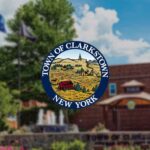As we continue to commemorate the 250th anniversary of the start of the American
Revolutionary War, a step back in time to the year 1775 shows how both our town and
our country were changing in transcendent ways. Let’s take a quick look back at how
this pivotal year shaped the course of history.
On March 3, 1775, the New York State Provincial Assembly first recognized what is now
the Town of Clarkstown as the “District of Clarkstown.” This designation stemmed from
land purchases made by a Dutch settler named Daniel DeClark, who acquired a large
area of land here in 1686. As DeClark’s family grew and other settlers arrived, our town
began to take shape. Mainly populated by Dutch emigrants who engaged in farming,
trapping, hunting, and fishing, the District of Clarkstown was a typical example of a rural
colonial settlement. And just like in many other colonies, frustration with British rule had
been growing. On July 4, 1774 our neighbors in Orangetown adopted the “Orangetown
Resolutions,” a document which expressed loyalty to the British Crown, but also
condemned the Intolerable Acts and called for “just and lawful” measures to repeal them
in order to “restore concord and harmony” to the colonies. These decrees were cautious
and balanced, but in less than a year more aggressive acts of rebellion would prevail.
By the spring of 1775, the colonies and Britain would be at war.
Just 47 days after the District of Clarkstown was recognized, the “shot heard ‘round the
world” was fired in Lexington, Massachusetts. On the morning of April 19, 1775, British
troops were sent to seize a cache of weapons and ammunition being stored by colonial
forces in the nearby town of Concord. On their way, the British troops happened upon
the colonial militia who had been dispatched to stop the British from seizing the
supplies. Although the colonial forces were quickly ordered into retreat, shots were fired
in the chaotic confrontation, and 7 colonists were killed. Later that afternoon, as the
British forces crossed the north bridge in Concord, another battle took place. Finding
themselves greatly outnumbered by an awaiting colonial militia, the British retreated
back across the bridge as the militia advanced upon them. The British fired first and the
colonists countered. As the British retreated further, they were relentlessly pursued and
engaged by the militia. By the end of the day, an estimated 73 British troops had been
killed along with 50 colonists.
Less than a month later, combined forces of a militia led by Ethan Allen and Continental
Army forces led by Benedict Arnold attacked and captured Fort Ticonderoga, a
strategically important British foothold located in upstate New York at the confluence of
Lake Champlain and Lake George. This fort controlled the passage to and from Canada
and its capture also provided colonial forces with a much-needed supply of weapons
and ammunition. This marked the first successful offensive victory by American forces in
the revolution.
With diplomacy looking less and less realistic as a solution, General George
Washington was appointed as Commander-in-Chief of the Continental Army on June
15, 1775. Merely two days later, fighting resumed in Boston at the Battle of Bunker Hill.
Having been surrounded in Boston by colonial forces since the Battle of Concord,
British General Thomas Gage had been increasingly pressured to take action to quash
the rebellion. On June 17, 1775, Gage sent troops to wipe out American encampments
on the heights north and south of Boston at Bunker Hill and Breed’s Hill. While the
British forces eventually forced the colonial fighters to abandon their positions, the
ragtag colonial group more than held their own and doled out incredible punishment to
the advancing British troops. British casualties were more than double those of the
colonial forces, and the British army remained surrounded and contained in Boston.
It’s quite interesting that just as Clarkstown was beginning to find its place on the map,
the whole map itself was about to change. Rockland County had not even been formed,
but yet the revolution would eventually make its way to our area, most notably in the
Battle of Stony Point and the “Treason Trail” of Benedict Arnold and Major John Andre.
It’s also somewhat remarkable that the year 1776 is still frequently perceived by many
as the start of the American Revolution when the reality is that the war was well
underway in 1775. The national movement to mark the 250th Anniversary of the start of
the American Revolution has been a great reminder of the monumental events that took
place prior to the Declaration of Independence in 1776, and has provided a spark of
curiosity to look back on what our town was like when the revolution began.
Wishing everyone a very happy and safe Independence Day!






